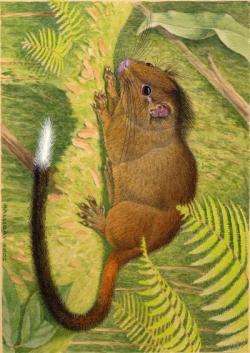Scientists discover new species of distinctive cloud-forest rodent

A strikingly unusual animal was recently discovered in the cloud-forests of Peru. The large rodent is about the size of a squirrel and looks a bit like one, except its closest relatives are spiny rats.
The nocturnal, climbing rodent is beautiful yet strange looking, with long dense fur, a broad blocky head, and thickly furred tail. A blackish crest of fur on the crown, nape and shoulders add to its distinctive appearance.
Isothrix barbarabrownae, as the new species has been named, is described in the current issue of Mastozoología Neotropical (Neotropical mammalogy), the principal mammalogy journal of South America. A color illustration of the bushy rodent graces the cover of the journal.
The authors of the study found the rodent in 1999 while conducting field research in Peru's Manu National Park and Biosphere Reserve Mountains in Southern Peru along the eastern slope of the Andes. Extending from lowland tropical forests in the Amazon Basin to open grasslands above the Andean tree line, Manu is home to more species of mammals and birds than any equivalently sized area in the world.
"Like other tropical mountain ranges, such as the Himalayas, Ruwenzoris, Virungas and Kinabalu, the Andes support a fantastic variety of habitats," said Bruce Patterson, MacArthur Curator of Mammals at The Field Museum. "These in turn support some of the richest faunas on the planet."
The new rodent was discovered at an altitude of 6,200 feet. Little is known about its lifestyle because subsequent efforts to locate and observe the animal were fruitless.
I. barbarabrownae belongs to a family of rodents known as "spiny rats" because most of the species in that family bristle with spines. Its discovery has necessitated a re-examination of this tropical American family, especially its closest relatives, the bush-tailed tree rats found in South America's lowlands. As a result of the recent discovery, the authors have used The Field Museum's Pritzker Lab for Molecular Systematics and Evolution to resolve the evolutionary relationships among all of these rodents.
"The new species is not only a handsome novelty," Patterson said. "Preliminary DNA analyses suggest that its nearest relatives, all restricted to the lowlands, may have arisen from Andean ancestors. The newly discovered species casts a striking new light on the evolution of an entire group of arboreal rodents."
Source: Field Museum















